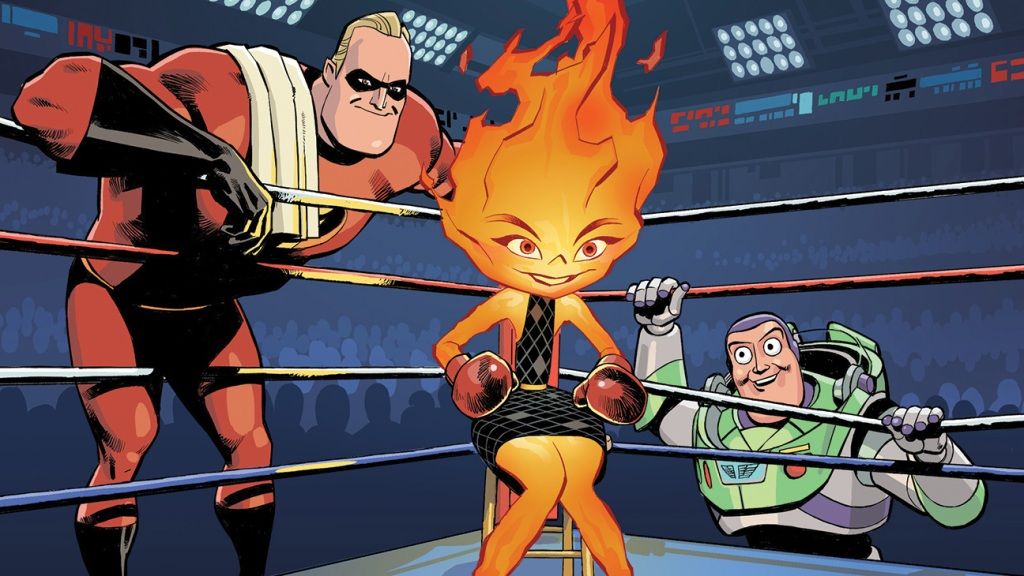The Hollywood Reporter
After one of the most impressive winning streaks in Hollywood history, Pixar has seen its fortunes reversed in recent years, with last year’s flop Lightyear and a pandemic-era policy of sending its features straight to streaming at Disney+. Now, Pixar faces a major test of brand strength as it prepares to unveil Elemental, its first original theatrical feature since COVID-19 hit.
Directed by Peter Sohn, the film is based on an original story set in a world where fire, water, earth and air residents live together. Among early reviews, the title has an underwhelming 64 percent approval rating on Rotten Tomatoes, a low number for Pixar. Additionally, the movie is tracking to soft numbers, just $37 million to $38 million over the June 16-18 opening weekend, which it shares with Warner Bros.’ The Flash. Only a handful of Disney’s releases have debuted to less than $50 million. (There were plenty of negative headlines when 2007’s Ratatouille opened to $47 million, but the naysayers were proven wrong when the pic transformed into a box office sensation.)
Before the pandemic, such an opening for a new Pixar title would have been hard to imagine. The Incredibles 2 (2019) and Toy Story 4 (2020) both ultimately topped $1 billion. Then, just as the crisis struck overseas and in the U.S., Pixar and Disney launched Onward in theaters in early March 2020. The film limped to a global gross of $133.4 million as theaters began shutting down en masse. The next three Pixar films — 2020’s Oscar-winning Soul, 2021’s Luca and 2022’s Turning Red — were sent straight to Disney+ in the U.S. and other select major markets, even though the box office was in recovery mode by the time Turning Red came out.
Many criticized Disney’s former Bob Chapek regime for training families to watch Pixar films in the comfort of their own living rooms versus promoting the theatrical experience. Lightyear was indeed released on the big screen in June 2022, several months after Turning Red. Although it was based on one of the studio’s most iconic Toy Story characters, it managed to earn only $218.8 million, an alarmingly low number for one of Pixar’s movies, which are believed to cost around $200 million to produce.
Elemental itself spanned the earlier and current creative regimes at the studio, with Sohn conceiving the idea for the story after directing 2015’s The Good Dinosaur, and was asked to speak at an event in the Bronx, where he was born. Seeing his immigrant parents in the audience “hit me very emotionally, and I broke down to tears,” he remembers. “That gesture of appreciating their plight and what they had given up and risked for me, really affected me. When I got back to Pixar, some friends and my bosses at the time said, ‘That’s your next movie.’”
Observers point not only to pandemic challenges but to a generational change in its leaders, particularly after the 2018 exit of longtime chief creative officer John Lasseter, who departed after acknowledging workplace “missteps” that left some employees feeling, as he wrote, “disrespected or uncomfortable.” (He now runs Skydance Animation.) Much has been made of the Pixar “brain trust” that provides creative guidance on each movie, and that too has seen change. “Many of the original Pixar brain trust that started the company are gone: Ed Catmull, John Lasseter, Steve Jobs, Brad Bird, story head Joe Ranft [who died in 2005] and more,” observes Tom Sito, an alum of Disney and DreamWorks Animation and an animation professor at USC.
Suggests one animation exec, “Their movies bring a diversity of filmmakers, but the richness and depth, which John brought, is just not there anymore.”
After Lasseter’s departure, veteran Pete Docter — who joined Pixar to work on Toy Story and, as director of Up, Inside Out and Soul, is the only director to have won three animated feature Oscars — was named the studio’s chief creative, and he enjoys wide support. “People love and respect Pete. No one is questioning his talents,” an animation source with past ties to Pixar says. “Animation is a long game. You can’t place too much in the success or lack of success of one movie.” Still, in June, Pixar — which maintains its campus in Emeryville, outside San Francisco — was hit by Disney layoffs, which affected 75 employees including Lightyear director Angus MacLane and producer Galyn Susman.
According to Sohn, Elemental’s brain trust included Docter and Andrew Stanton (Finding Nemo, Wall-E), along with Dan Scanlon (Onward), Domee Shi (Turning Red), Julia Cho (a Turning Red writer) and Brian Larsen (head of story on Oscar-winning short Piper).
As the next chapter of Pixar is written, the animation world itself is becoming more competitive and crowded. This year alone, Illumination Entertainment — the Chris Meledandri-led home of the Minions franchise — had a massive hit in The Super Mario Bros. Movie, which has topped $1.2 billion worldwide. Sony Pictures Animation’s Spider-Man: Across the Spider-Verse, the sequel to its Oscar-winning Into the Spider-Verse, has already claimed $208.6 million worldwide since its May 30 release.
Netflix — which has become a force in animation, with Guillermo del Toro’s Pinocchio winning the best animated feature Oscar earlier this year — boasts a 2023 slate that includes the anticipated Nimona, based on the graphic novels of the same name, and Chicken Run: Dawn of the Nugget, the long-awaited sequel to Wallace & Gromit studio Aardman’s Chicken Run.
Pixar’s sister company, Walt Disney Animation Studios, will next release Wish (the story of the star that Disney characters wish upon) in November. But Disney Animation also has had an uneven record of late, after the release of 2022’s Strange World, which made just $73.6 million. Further out, Pixar is planning a mix of what they hope will be dependable sequels and original fare. An Inside Out sequel and an original alien tale titled Elio are expected for 2024. A fifth Toy Story movie has also been announced.
Observers note that part of Pixar’s success — which includes 11 best animated feature Oscars — was the result of being left to its own devices, with a management team that’s separate from the rest of Disney. Says Sito, “Since the Toy Story days, there have been executives in Burbank envious of their autonomy, but no one dared question it when the results were so good.”
Pamela McClintock and Borys Kit contributed to this report.
A version of this story first appeared in the June 7 issue of The Hollywood Reporter magazine. Click here to subscribe.
Source: Hollywood Reporter


